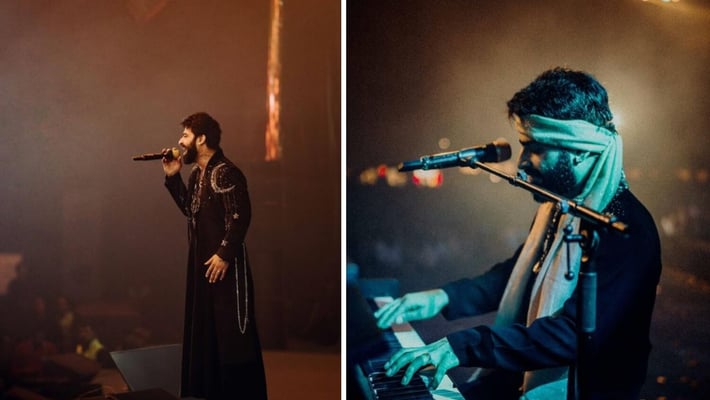New classical ballet to delight the senses

"Flowers open in the hands of the dancer, and birds fly off from the tips of fingers, each muscle of the face is transformed, the eyes move in blandishments of scorn, and the eyebrows express horror or suspicion, even as the whole face expresses different and often contrary feelings in the same breath such as dance drama, performed according to the most delicate nuances of a musical piece, or a poem, through the vehicle of one body, is surely unmatched in any art."
- Mulk Raj Anand, BHARATA NATYAM
Such an exquisite art form is Bharata Natyam.
Bharata Natyam springs from the most important ancient treatise encompassing theatre, dance and music, the Natya Shastra. Written by sage Bharata Muni, it is treasured as the “fifth veda” in terms of its importance among Hindu religion and philosophy. As an extremely traditional dance form, Bharata Natyam is known for its grace, purity, tenderness, statuesque & sculpturesque poses.
Originating from the southern Indian state of Tamil Nadu, Bharata Natyam started as a temple dance tradition, Dasiyattam. It is perhaps the most evolved of all Indian classical dance forms. Chinnayya, Ponniah, Sivanandam and Vadivelu of the Tanjore Court, fondly known as the Tanjore ‘quartet’, made a rich contribution to the dance form during the 19th Century. They completed the process of re-editing the former Bharata Natyam programme, and established its present shape and variety of items.
However, it was only after its revival during the 20th century that Bharata Natyam gained its place in the social realm. Philanthropists and dance lovers including E Krishna Iyer and Rukmini Devi Arundale played pivotal roles in the successful movement to establish Bharata Natyam as a more socially accepted art form. Today, this dance style is an immensely popular form of cultural expression, a source of deep pride among the Indian Diaspora communities around the world.
Bharata Natyam proper is a solo dance, with two aspects, Lasya, the graceful feminine lines and movements, and Tandava, the masculine aspect. Considered to represent ‘fire’ among the five elements, the movements of an authentic Bharata Natyam dancer are thought to resemble the movements of a dancing flame. Others among the five major styles include Odissi, considered to represent the element of water, Mohiniattam representing air, Kuchipudi representing earth, and Kathakali representing sky.
The science and technique behind Bharata Natyam are overwhelming. Basically divided into three features, Bharata Natyam includes Nritta (rhythmic dance movements), Natya (mime), and Nritya (combination of Nritta and Natya). Furthermore, Abhinaya is the art of communicating an emotion (Bhava) to evoke a sentiment/ aesthetic enjoyment (Rasa). To evoke such a sentiment is the ultimate aim of every Bharata Natyam recital. Nritya and Abhinaya stands for dance which expresses ideas or sentiments.
Nrityabhinaya is proud to serve to the community the tutelage of as a splendid an art form as Bharata Natyam. To nurture a fine dancer in every student, to infuse in them essential cultural values, and to deliver quality classical dance performances are the means by which the school upholds the Indian heritage. Nrityabhinaya’s forthcoming musical and dance extravaganza, Sree Rama, will be nothing short of a feast for your eyes.
Sree Rama, a Bharata Natyam dance drama – experience it for yourself!
Indian Weekender & Cultural Forum of India present
Shree Rama Bharat Natyam Dance Drama
Date: Saturday 02 October 06:30:00 PM
Venue: Dorothy Winstone Centre, 16 Howe Street Newton, Auckland
Produced and Choreographed by Anuradha Ramkumar
Tickets $25 Call Anuradha 09-627 4117 or 021 155 0714
Email: sreerama2010@hotmail.com
"Flowers open in the hands of the dancer, and birds fly off from the tips of fingers, each muscle of the face is transformed, the eyes move in blandishments of scorn, and the eyebrows express horror or suspicion, even as the whole face expresses different and often contrary feelings in the same...
"Flowers open in the hands of the dancer, and birds fly off from the tips of fingers, each muscle of the face is transformed, the eyes move in blandishments of scorn, and the eyebrows express horror or suspicion, even as the whole face expresses different and often contrary feelings in the same breath such as dance drama, performed according to the most delicate nuances of a musical piece, or a poem, through the vehicle of one body, is surely unmatched in any art."
- Mulk Raj Anand, BHARATA NATYAM
Such an exquisite art form is Bharata Natyam.
Bharata Natyam springs from the most important ancient treatise encompassing theatre, dance and music, the Natya Shastra. Written by sage Bharata Muni, it is treasured as the “fifth veda” in terms of its importance among Hindu religion and philosophy. As an extremely traditional dance form, Bharata Natyam is known for its grace, purity, tenderness, statuesque & sculpturesque poses.
Originating from the southern Indian state of Tamil Nadu, Bharata Natyam started as a temple dance tradition, Dasiyattam. It is perhaps the most evolved of all Indian classical dance forms. Chinnayya, Ponniah, Sivanandam and Vadivelu of the Tanjore Court, fondly known as the Tanjore ‘quartet’, made a rich contribution to the dance form during the 19th Century. They completed the process of re-editing the former Bharata Natyam programme, and established its present shape and variety of items.
However, it was only after its revival during the 20th century that Bharata Natyam gained its place in the social realm. Philanthropists and dance lovers including E Krishna Iyer and Rukmini Devi Arundale played pivotal roles in the successful movement to establish Bharata Natyam as a more socially accepted art form. Today, this dance style is an immensely popular form of cultural expression, a source of deep pride among the Indian Diaspora communities around the world.
Bharata Natyam proper is a solo dance, with two aspects, Lasya, the graceful feminine lines and movements, and Tandava, the masculine aspect. Considered to represent ‘fire’ among the five elements, the movements of an authentic Bharata Natyam dancer are thought to resemble the movements of a dancing flame. Others among the five major styles include Odissi, considered to represent the element of water, Mohiniattam representing air, Kuchipudi representing earth, and Kathakali representing sky.
The science and technique behind Bharata Natyam are overwhelming. Basically divided into three features, Bharata Natyam includes Nritta (rhythmic dance movements), Natya (mime), and Nritya (combination of Nritta and Natya). Furthermore, Abhinaya is the art of communicating an emotion (Bhava) to evoke a sentiment/ aesthetic enjoyment (Rasa). To evoke such a sentiment is the ultimate aim of every Bharata Natyam recital. Nritya and Abhinaya stands for dance which expresses ideas or sentiments.
Nrityabhinaya is proud to serve to the community the tutelage of as a splendid an art form as Bharata Natyam. To nurture a fine dancer in every student, to infuse in them essential cultural values, and to deliver quality classical dance performances are the means by which the school upholds the Indian heritage. Nrityabhinaya’s forthcoming musical and dance extravaganza, Sree Rama, will be nothing short of a feast for your eyes.
Sree Rama, a Bharata Natyam dance drama – experience it for yourself!
Indian Weekender & Cultural Forum of India present
Shree Rama Bharat Natyam Dance Drama
Date: Saturday 02 October 06:30:00 PM
Venue: Dorothy Winstone Centre, 16 Howe Street Newton, Auckland
Produced and Choreographed by Anuradha Ramkumar
Tickets $25 Call Anuradha 09-627 4117 or 021 155 0714
Email: sreerama2010@hotmail.com









Leave a Comment